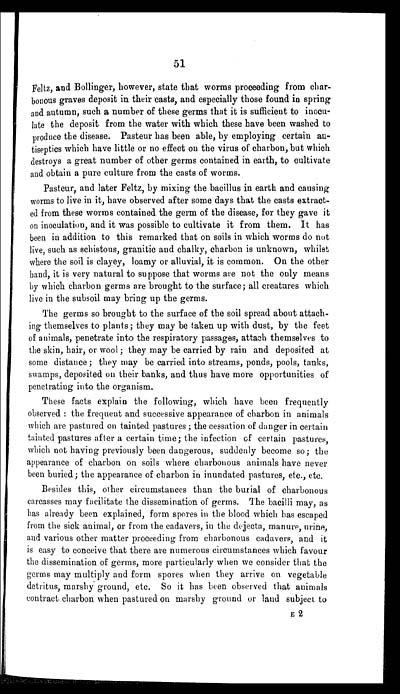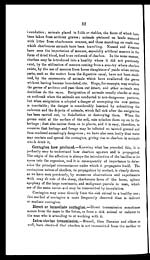Medicine - Veterinary > Civil Veterinary Departments > Civil Veterinary Department ledger series I-VI > Volume II - Anthrax
(197) Page 51
Download files
Individual page:
Thumbnail gallery: Grid view | List view

51
Feltz, and Bollinger, however, state that worms proceeding from char-
bonous graves deposit in their casts, and especially those found in spring
and autumn, such a number of these germs that it is sufficient to inocu-
late the deposit from the water with which these have been washed to
produce the disease. Pasteur has been able, by employing certain an-
tiseptics which have little or no effect on the virus of charbon, but which
destroys a great number of other germs contained in earth, to cultivate
and obtain a pure culture from the casts of worms.
Pasteur, and later Feltz, by mixing the bacillus in earth and causing
worms to live in it, have observed after some days that the casts extract-
ed from these worms contained the germ of the disease, for they gave it
on inoculation, and it was possible to cultivate it from them. It has
been in addition to this remarked that on soils in which worms do not
live, such as schistous, granitic and chalky, charbon is unknown, whilst
where the soil is clayey, loamy or alluvial, it is common. On the other
hand, it is very natural to suppose that worms are not the only means
by which charbon germs are brought to the surface; all creatures which
live in the subsoil may bring up the germs.
The germs so brought to the surface of the soil spread about attach-
ing themselves to plants; they may be taken up with dust, by the feet
of animals, penetrate into the respiratory passages, attach themselves to
the skin, hair, or wool; they may be carried by rain and deposited at
some distance; they may be carried into streams, ponds, pools, tanks,
swamps, deposited on their banks, and thus have more opportunities of
penetrating into the organism.
These facts explain the following, which have been frequently
observed: the frequent and successive appearance of charbon in animals
which are pastured on tainted pastures; the cessation of danger in certain
tainted pastures after a certain time; the infection of certain pastures,
which not having previously been dangerous, suddenly become so; the
appearance of charbon on soils where charbonous animals have never
been buried; the appearance of charbon in inundated pastures, etc., etc.
Besides this, other circumstances than the burial of charbonous
carcasses may facilitate the dissemination of germs. The bacilli may, as
has already been explained, form spores in the blood which has escaped
from the sick animal, or from the cadavers, in the dejecta, manure, urine,
and various other matter proceeding from charbonous cadavers, and it
is easy to conceive that there are numerous circumstances which favour
the dissemination of germs, more particularly when we consider that the
germs may multiply and form spores when they arrive on vegetable
detritus, marshy ground, etc. So it has been observed that animals
contract charbon when pastured on marshy ground or land subject to
E2
Set display mode to: Large image | Zoom image | Transcription
Images and transcriptions on this page, including medium image downloads, may be used under the Creative Commons Attribution 4.0 International Licence unless otherwise stated. ![]()
| India Papers > Medicine - Veterinary > Civil Veterinary Departments > Civil Veterinary Department ledger series I-VI > Anthrax > (197) Page 51 |
|---|
| Permanent URL | https://digital.nls.uk/75516366 |
|---|




